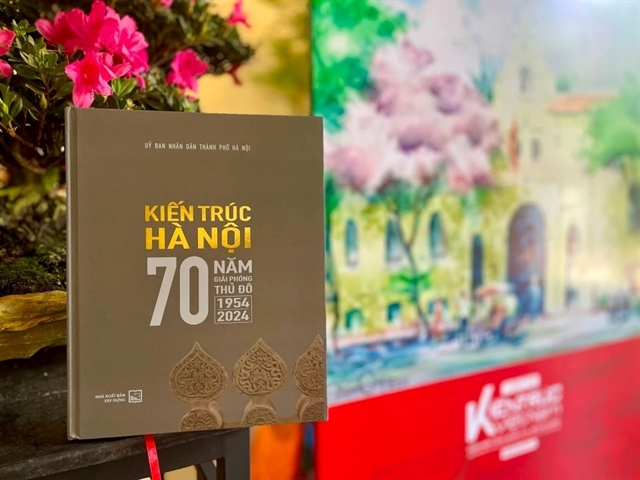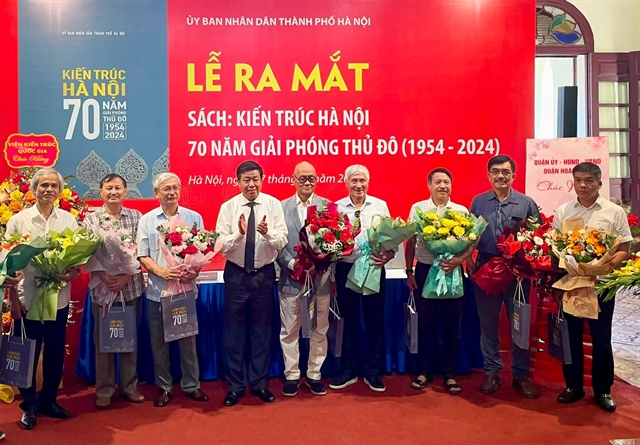HÀ NỘI – The evolution of Hà Nội’s architecture and urban planning over the past seven decades since the liberation of the capital in 1954 is presented in a newly released book that was launched in the capital on Monday.
The book, titled Kiến Trúc Hà Nội – 70 Năm Giải Phóng Thủ Đô (1954 - 2024) (Hà Nội Architecture – 70 Years of Capital Liberation), was published to celebrate the 70th anniversary of the city’s Liberation Day (October 10, 1954 – October 10, 2024).

The cover of the newly-released book Kiến Trúc Hà Nội – 70 Năm Giải Phóng Thủ Đô (1954 - 2024) (Hà Nội Architecture – 70 Years of Capital Liberation). Photo hanoimoi.vn
At the book launch, deputy chairman of Hà Nội People’s Committee Dương Đức Tuấn said that after 70 years of development, Hà Nội now has become a modern and distinctive city, with an integrated yet individualistic character.
“Hà Nội seamlessly blends the nation’s cultural essence within its architectural heritage and urban landscapes, reflecting the continuous creativity of its people. This fusion shapes the image of a cultured, civilised and modern capital,” said Tuấn, who is also an architect.
He added that Hà Nội is indeed a special capital, the history and identity of which have been accumulated through both space and time, from legends and stories to the long journey of nation-building and defence. Its architecture and landscapes might not be overwhelming, but they are deeply imprinted in the memories of generations.
Despite numerous studies on Hà Nội, understanding the city in its entirety remains a challenge. The city's government has therefore worked to enrich knowledge and scientific research on the capital city, particularly in architecture and urban planning.

Deputy chairman of Hà Nội People’s Committee Dương Đức Tuấn (4th left) poses for a photo with the group of experts and specialists, whose researches and writings have been featured in the book Kiến Trúc Hà Nội – 70 Năm Giải Phóng Thủ Đô (1954 - 2024). Photo hanoimoi.vn
Featuring the result of a research project by experts in Hà Nội's architecture and urban planning, the book harmoniously combines two perspectives. The first perspective focuses on analysing the transformation of urban architectural forms over time and across different genres. This section delves into the development of Hà Nội's architecture, categorised by specific periods over the past 70 years.
For each period, the authors analyse the socio-economic context, impact of legal frameworks, management and development orientation documents. They also cover areas like residential architecture, public buildings, rural and urban technical infrastructure and architectural changes resulting from new technologies.
The second perspective delves into views, studies and analyses of the identity behind Hà Nội's architecture and urban planning. It encapsulates the aspirations of the architects and proposals for a modern, culturally rich and community-oriented Hà Nội.
Exhibition featuring ancient gates

Visitors view photos at Hà Nội and Ancient Gates exhibition. VNA/VNS Photo Phương Thảo
Nearly 200 documents and photos featuring Hà Nội's ancient gates are being displayed at the Thăng Long Imperial Citadel for the 70th anniversary of the capital city’s liberation.
According to historical records, there once was a wall with many gates surrounding the citadel, called Cầu Giấy, Cầu Dền, Chợ Dừa, Đông Mác and Quan Chưởng. Quan Chưởng is the only remaining gate today, while the others became public sites or were damaged during wartime.
The exhibition gives an insight into the daily activities of residents around the gates, while educating young generations about national traditions and encouraging them to contribute more to building a modern, civilised capital city with long-standing culture.
Đặng Thanh Tùng, Director of the State Records and Archives Department, said the gates once witnessed various milestones in Hà Nội's history, notably the revolutionary troops marching into the city to take it over from French forces on October 10, 1954.
Apart from the stories relating to the gates, the exhibition also captures Hà Nội's development over the past 70 years. It runs until October 30.
Hà Nội was presented with the 'City for Peace' award by UNESCO in 1999. It also joined the UNESCO Creative Cities Network in the 'Design' category in 2019. VNS
OVietnam